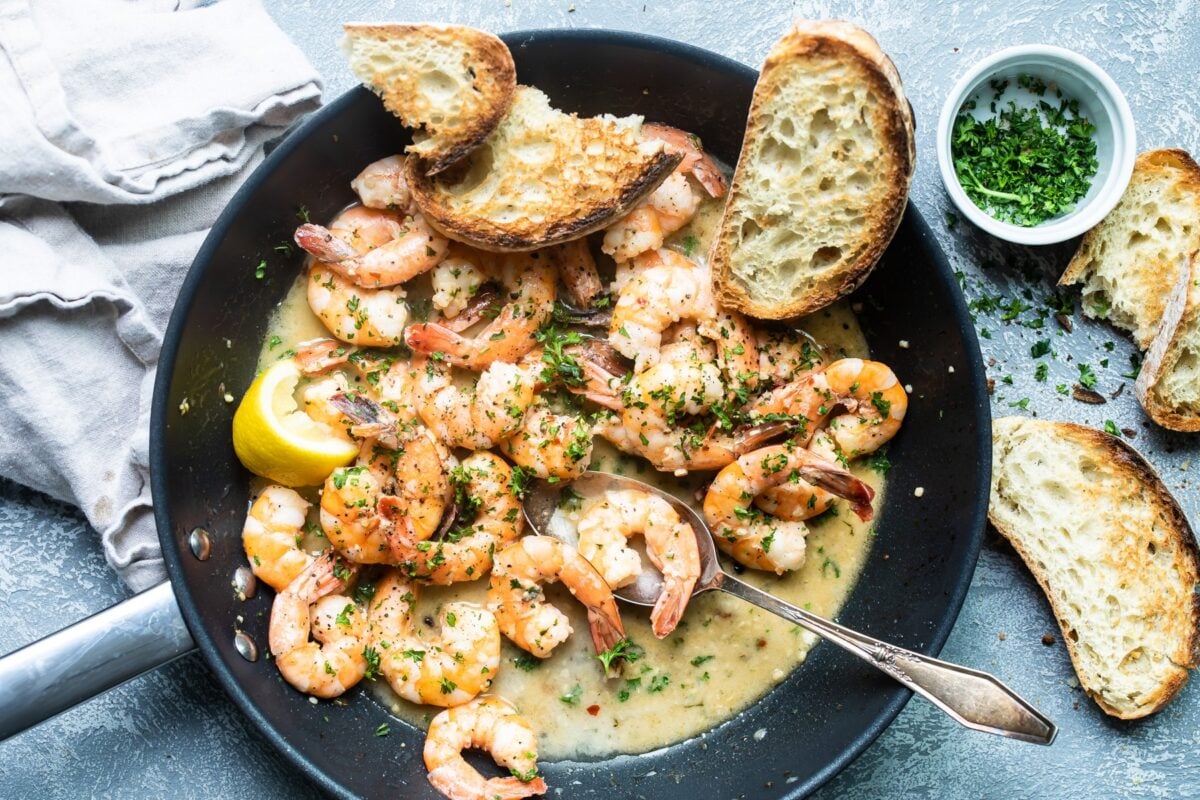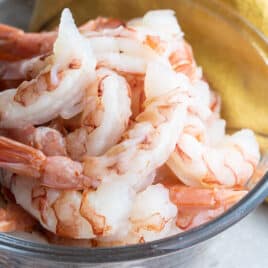Hey there! I’m a seafood enthusiast and professional food writer who’s cleaned thousands of shrimp in my culinary journey Today, I’m gonna share everything I know about properly cleaning shrimp – from selecting the right ones to getting them squeaky clean for your favorite recipes
Buying the Right Shrimp First
Before we dive into cleaning, let’s talk about picking good shrimp:
Fresh vs. Frozen
Here’s a lil secret – unless you live right by the coast frozen shrimp is actually your best bet! Why? Because
- Most “fresh” shrimp at stores was previously frozen anyway
- Frozen shrimp are typically frozen right on the boat
- You control when to thaw them, ensuring maximum freshness
Size Matters
Shrimp sizes can be confusing! Here’s a quick guide:
- U10 (Extra Colossal): Under 10 per pound
- U15 (Colossal): Under 15 per pound
- 16/20 (Extra Jumbo): 16-20 per pound
- 26/30 (Extra Large): 26-30 per pound
Pro tip: The smaller the number, the bigger the shrimp!
Step-by-Step Cleaning Process
What You’ll Need
- Kitchen shears or sharp paring knife
- Clean bowl
- Paper towels
- Colander (optional)
Step 1: Thawing (if using frozen)
Got frozen shrimp? You’ve got 2 options
Overnight Method:
- Place bag in fridge
- Put on a tray/bowl (in case of leaks)
- Leave overnight
Quick Method:
- Place shrimp in bowl of cold water
- Run thin stream of cold water over them
- They’ll thaw in few minutes
Step 2: The Shell Game
Here’s my preferred method:
- Hold shrimp with curve facing up
- Snip along the outer curve with kitchen shears
- Peel shell away from either side
- Decision time: leave tail on or off?
- Leave on: Great for finger foods like shrimp cocktail
- Take off: Better for pasta dishes or stir-fries
Step 3: Dealing with “The Vein”
Okay, let’s be real – that black line isn’t actually a vein. It’s the shrimp’s digestive tract (yeah, it’s poop). While it won’t hurt ya to eat it, most of us prefer to remove it:
- Make shallow cut along shrimp’s back
- Use knife tip or shears to lift out the dark vein
- Usually comes out in one piece (if it breaks, just grab the pieces)
- Give a quick rinse
- Pat dry with paper towels
Pro Tips & Tricks
Save Those Shells!
Don’t toss those shells! They make amazing seafood stock. Just:
- Collect shells in freezer bag
- Store until you have about 4 cups
- Use for killer risotto or bisque
When to Clean
Different dishes need different timing:
- Clean before cooking: Pasta, stir-fries, fajitas
- Clean after cooking: Cold dishes like shrimp salad
Cleaning Unpeeled Shrimp
Yep, you can clean shrimp while leaving shells on! Just:
- Cut through shell along back
- Remove vein
- Leave shell intact
Perfect for dishes where you want that extra shell flavor!
Common Questions I Get
Q: Do I really need to remove the vein?
A: Technically no – it won’t hurt you. But it can be gritty and doesn’t look great. My rule: if you can see it, remove it!
Q: How long do cleaned shrimp last?
A: Use within 1-2 days if stored in fridge. Keep them in bottom drawer to prevent drips!
Q: Can I clean shrimp ahead of time?
A: You can, but I’d recommend cleaning just before cooking for best results.
Final Thoughts
Cleaning shrimp might seem fiddly at first, but trust me – you’ll be a pro after doing a few! The effort is totally worth it for better quality and value compared to pre-cleaned shrimp.
Remember, practice makes perfect. Don’t stress if your first few aren’t magazine-worthy. As long as the shell and vein are gone, you’re good to go!
Would love to hear your shrimp-cleaning adventures or answer any questions in the comments below! Happy cooking!
Note: This guide is based on my personal experience and professional training. Feel free to adapt these techniques to what works best for you!

Tutorial tips and variations
- Shrimp sizes: On the boat and at the factory, shrimp are sorted by size and given a number. This number lets you know how many shrimp come in a pound. For example, the numbers 16/20 tells you that there are anywhere from 16 to 20 shrimp per pound. Other times, you may see the letter U before a number, like U10. That means that there are approximately 10 shrimp (or under) per pound.
- The higher the number, the smaller the shrimp. The lower the number, the larger (and pricier) the shrimp. Don’t be afraid to go small. Tiny shrimp are delicious choices for shrimp salad, stir-fry, or a big batch of fried rice. Save the biggest shrimp for making big impressions (think super fancy shrimp cocktail or shrimp skewers).
- Extra colossal shrimp: U10 shrimp = under 10 shrimp per pound
- Colossal shrimp: U15 shrimp = under 15 shrimp per pound
- Extra jumbo shrimp: 16/20 shrimp = 16 to 20 shrimp per pound
- Extra large shrimp: 26/30 shrimp = 26 to 30 shrimp per pound
- Fresh vs. frozen shrimp: Unless you live right on the coast, the best choice is frozen shrimp. I always buy frozen shrimp, because almost all shrimp that comes to us has been previously frozen, usually as soon as it’s caught on the boat. When you thaw shrimp at home, you’re getting the absolute freshest shrimp possible. When you buy “fresh” shrimp at the grocery store, someone else has thawed it, but you don’t know when. Might as well just buy frozen.
- How to buy shrimp: Use your senses when shopping for shrimp. Good quality, freshest-of-the-fresh shrimp should smell briny and even sweet, like the ocean. Go somewhere else if the shrimp smell like ammonia, are slimy, and have black spots on the shells, which is a sign of age.
- How to store shrimp: Store fresh or thawed shrimp in the bottom drawer of your refrigerator (so any leaks do not contaminate other items in the fridge). Use fresh or thawed shrimp with 1 to 2 days.
- Wild vs. farmed shrimp: That depends on your and your grocery budget. Wild-caught shrimp have a stronger flavor, but can cost a lot more. Farm-raised shrimp from a sustainable, responsible grower is a good option if you can find it. If you’re in doubt, read the packaging carefully: shrimp farmers are proud of their sustainability efforts and will advertise it on the label. Learn all the latest news at SeafoodWatch.org.
- Shrimp stock: Save those shells in your freezer and make a delicious batch of Homemade Shrimp Stock. You’ll need 4 cups of shrimp shells from 2 pounds of shrimp for this recipe. But you can gather it in batches: save uncooked shrimp shells in a plastic bag in your freezer until you have enough. Technically, you can make stock with cooked shells, but the flavor will be weaker. Using shrimp stock for future seafood sauce will ensure a robust flavor of the ocean.

Technically, no. The little black line on the bottom of the shrimp, also called a “vein,” is just a digestive tract. Depending on what the shrimp ate before it was caught, it could be darker than the rest of the meat and might contain sand or algae. It could have some sand in it, or algae. While some people consider it unsightly or are turned off by “shrimp poop”, it really isn’t harmful to eat. It just looks better without it.
Peeling shrimp before eating them makes for a better eating experience texture-wise, but it isn’t absolutely necessary depending on the dish. I know lots of folks who love their spiced, in-the-peel boiled shrimp sold in seafood markets on the East Coast.
Fish and Seafood Recipes

